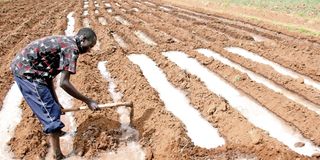Agronomist notebook: Dos, don’ts of using furrow irrigation

Mike Kigen makes furrows for irrigating his farm at the Perkerra Irrigation Scheme in Marigat, Baringo County in this past photo. Due to high initial cost of investments, most small-scale farmers often prefer to use furrow irrigation systems, which come with numerous challenges that include overflow to neighbouring farms. PHOTO | FILE | NATION MEDIA GROUP
What you need to know:
- Drip irrigation systems are the most efficient as they help in water conservation and prevent the spread of fungal diseases such as black rot in cabbages and blight in tomatoes.
- Once one furrow is filled, the water is directed to the next, until the entire farm is irrigated. The water flows by gravity. However, one may need to pump the water from the source.
- Design your irrigation system depending on the crops you intend to grow and ensure you have an adequate source of clean water that can be used for production.
- Watering is best done late in the evening since, during the day, this results in a high evaporation rate.
As the weather becomes extremely unpredictable, with dry spells becoming frequent, the use of irrigation is inevitable for increased food production.
There are factors one must consider before investing in an irrigation system. These include the topography, type of crop to be grown and the cost of installation.
Drip irrigation systems are the most efficient as they help in water conservation and prevent the spread of fungal diseases such as black rot in cabbages and blight in tomatoes.
However, due to high initial cost of investment, most small-scale farmers use furrow irrigation systems, which come with numerous challenges that include overflow to neighbouring farms.
So what does it take to have a quality furrow irrigation system? Furrows are normally created between the crop rows, allowing water to pass through and soak the roots slowly.
Once one furrow is filled, the water is directed to the next, until the entire farm is irrigated. The water flows by gravity. However, one may need to pump the water from the source.
When setting up the irrigation system, a farmer should be involved in the design process, especially on the marking of the boundaries and the layout systems as this prevents damages such overflow to adjacent farms.
Design your irrigation system depending on the crops you intend to grow and ensure you have an adequate source of clean water that can be used for production.
The amount of water that the crops require depend on the local climatic conditions, type of soil, crop variety, the growth stage of the crop and the degree to which the crop may be stressed.
FREQUENT BREAKDOWNS
Furrow irrigation system works well in clay loamy soil, which can hold water for a longer duration due to its good holding capacity.
While putting water into the furrows, one should open one at a time and close the one that is filled.
This would easily enable the farmer to irrigate twice per day depending on the weather conditions and stage of growth of the crops. Ensure the furrows are long enough, not too short and not too shallow to avoid water wastage.
If you are pumping water into the furrows, ensure you buy a quality machine to save on the cost of maintenance arising from frequent breakdowns. It’s also crucial to get technical advice on the installation and operation of the equipment.
Check the topography of the land as this affects the flow of water on the farm. On a slopy land, one would end up using more power to pump the water if the source is on the lower side, increasing the cost of production.
Watering is best done late in the evening since, during the day, this results in a high evaporation rate.
Provide the crop with adequate water as excess watering results in logging, which makes it hard for the plants to absorb the nutrients. Excess watering also creates a conducive environment for diseases such as damping.
If planting spinach, make furrows to allow water to pass in between. Check on the crop spacing since if they are too close, this encourages the spread of fungal diseases.
Ensure the furrow does not pass too close to the root systems of the crop to avoid exposure of the roots affecting crop growth.





